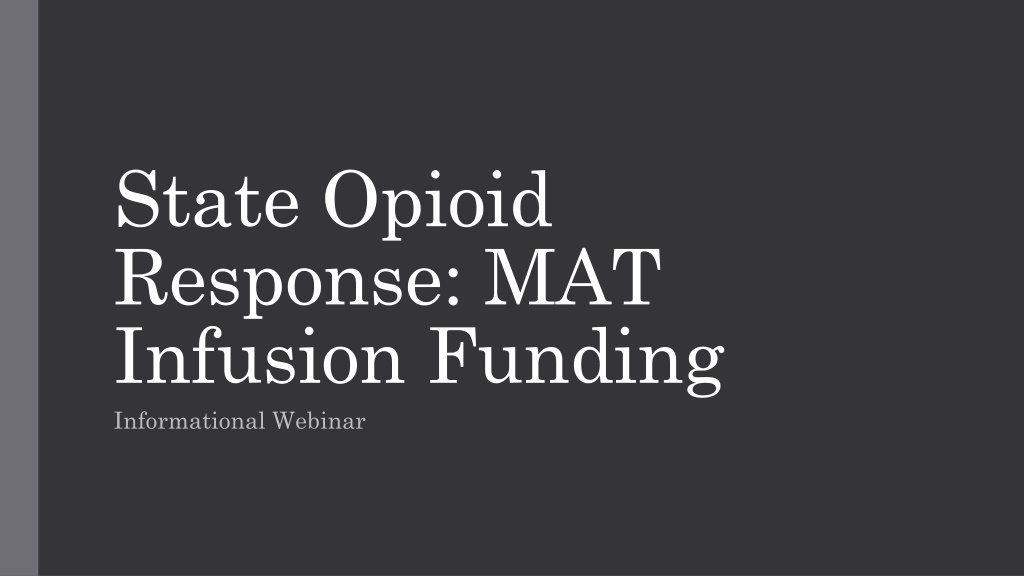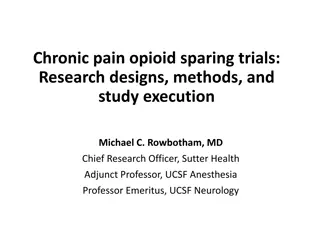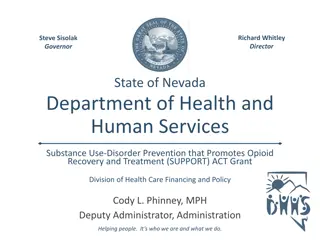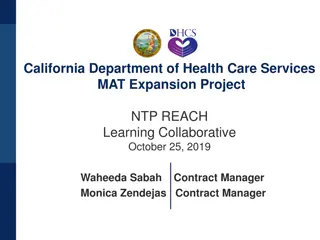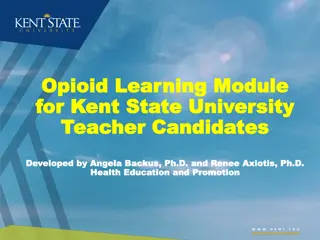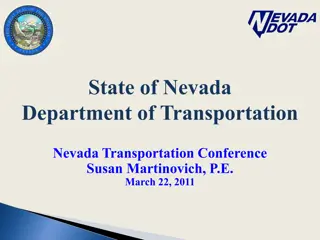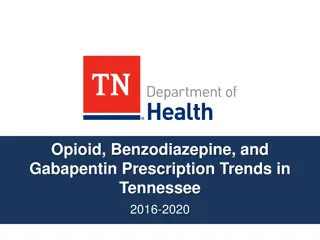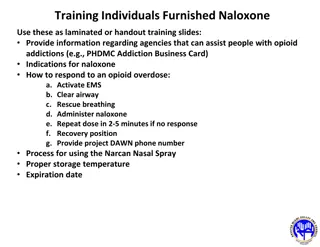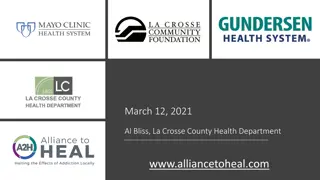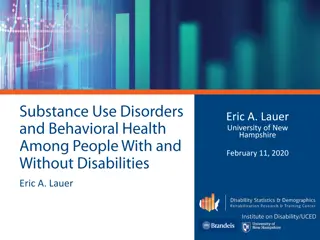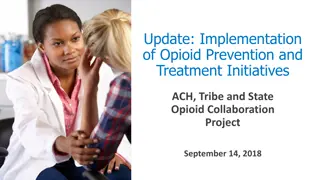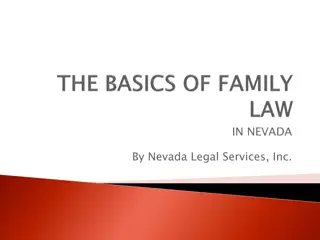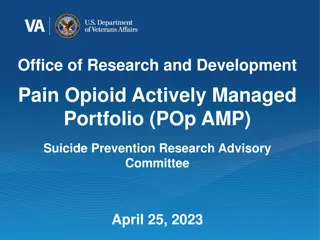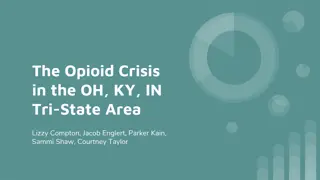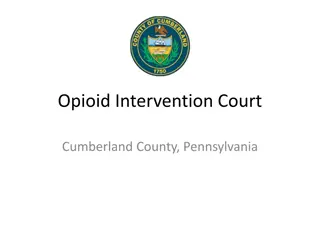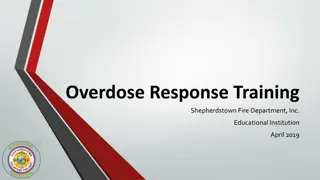State of Nevada Opioid Response Services Expansion Funding Opportunity
This funding opportunity under the State Opioid Response program in Nevada aims to expand opioid response services in various categories with a total funding of $1,000,000 available. Eligible organizations must provide services in specified counties, with a focus on Rural/Frontier areas. The application process includes specific timelines for submission and evaluation, leading to grant awards for selected applicants.
Download Presentation

Please find below an Image/Link to download the presentation.
The content on the website is provided AS IS for your information and personal use only. It may not be sold, licensed, or shared on other websites without obtaining consent from the author. Download presentation by click this link. If you encounter any issues during the download, it is possible that the publisher has removed the file from their server.
E N D
Presentation Transcript
State Opioid Response: MAT Infusion Funding Informational Webinar
SOR is authorized under Title II Division H of the Consolidated Appropriations Act, 2018. This announcements addresses Healthy People 2020, substance abuse topic area HP 2020-SA. All grants and sub-awards made under this announcement are governed by 45 CFR Part 75
State of Nevada Opioid Response Services Expansion Funding Opportunity Title: Funding Opportunity Number: Due Date for Applications: Anticipated Total Funding Available: Estimated Number of Award(s): Estimated Award Amount: NV SOR-03 March 19, 2020 (by noon PST) $1,000,000 Varies by category Categories 1, 2, 3, 4, 5: Award ceiling per organization will be between $50,000 - $100,000 Category 6: Award ceiling per organization will be $10,000-$25,000. *The University of Nevada, Reno reserves the right to reapply funds to any given category based on the applications received Cost Sharing/Match Required: None Project Period: Eligible Applicants: May 1, 2020 August 31, 2020. Counties Local Jurisdictions Heath Departments Certified Community Behavioral Health Centers (CCBHC) Community-Based Organizations EMS First Responder Organizations Federally Qualified Health Centers (FQHC) Indian Health Centers Licensed Medical Facilities Licensed Medical Providers Opioid Treatment Providers (OTP) Peer Recovery Organizations SAPTA Certified Providers Specialty Courts, Jails, Prisons, Law Enforcement Other Organizations meeting the additional eligibility requirements If providing direct treatment services (e.g. SUD), the applicant organization must have an established service delivery system in place for a minimum of two years. Additional Information on Eligibility: Program locations must be providing services in at least one of the required geographical areas (counties) with priority given to Rural/Frontier counties: Carson, Churchill, Clark, Douglas, Elko, Esmeralda, Eureka, Humboldt, Lander, Lincoln, Lyon, Mineral, Nye, Pershing, Storey, Washoe, or White Pine
Request for Application Timeline TASK DUE DATE & TIME UNR/CASAT distributes the Request for Application Guidance with all submission forms February 19, 2020 Q&A Written Questions due to CASAT February 21, 2020 Informational Webinar to address questions February 26, 2020 (1:00 pm 2:00pm) Letter of Intent Due February 28, 2020 by 5:00 pm March 19, 2020 by noon Deadline for submission of applications Technical Review of Applications March 19-20, 2020 UNR/CASAT will notify organizations that have discrepancies within their application. March 20, 2020 Evaluation Period: Content review of applications Interviews with Applicants March 23-27, 2020 March 30-31, 2020 Funding Decisions Announced UNR/CASAT will notify organizations via e-mail to the listed Project Director April 10, 2020 Completion of subgrant awards for selected awardees on or before May 1, 2020 Grant Award Commencement of Project Pending approved SAMHSA grant award and receipt of Notice of Award May 1, 2020
Funding Categories Outpatient Clinical Treatment and Recovery Services Medication Assisted Treatment Expansion for SAPTA-Certified Providers Tribal Treatment and Recovery Services Peer Recovery Support Services Enhanced supports for children and/or families impacted by opioid use utilizing evidence-based practices to including home-visiting and/or strategies to address trauma and adverse childhood experiences. Innovative considerations and planning
Grantees will be required to do the following Use epidemiological data to demonstrate the critical gaps in availability of treatment for OUDs in geographic, demographic, and service level terms; Utilize evidence-based implementation strategies to identify which system design models will most rapidly and adequately address the gaps in their systems of care; Deliver evidence-based treatment interventions that include medication(s) FDA-approved specifically for the treatment of OUD, and psychosocial interventions; report progress toward increasing availability of medication-assisted treatment for OUD and reducing opioid-related overdose deaths; Describe how your organization will expand access to overdose prevention, treatment and recovery support services; Describe how you will advance substance misuse prevention in coordination with other efforts occurring throughout the State of Nevada. Describe how you will improve retention in care, using a chronic care model or other innovative model that has been shown to improve retention in care. Note: Funding is to supplement and not supplant existing opioid prevention, treatment and recovery activities within your organizational service area.
Expectations Grantees will develop and provide opioid misuse prevention, treatment, and recovery support services for the purposes of addressing the opioid abuse and overdose crisis within Nevada. The use of these funds requires that only evidence-based treatments, practices and interventions for OUD be used by grantees and subgrantees. SAMHSA requires that FDA-approved medication-assisted treatment (MAT) be made available to those diagnosed with OUD. FDA-approved MAT for OUD includes methadone, buprenorphine products, including single-entity buprenorphine products, buprenorphine/naloxone tablets, films, buccal preparations, long-acting injectable buprenorphine products, buprenorphine implants, and injectable extended-release naltrexone. Medical withdrawal (detoxification): is not the standard of care for OUD, is associated with a very high relapse rate, and significantly increases an individual s risk for opioid overdose and death if opioid use is resumed. Therefore, medical withdrawal (detoxification) when done in isolation is not an evidence-based practice for OUD. If medical withdrawal (detoxification) is performed, it must be accompanied by injectable extended-release naltrexone to protect such individuals from opioid overdose in relapse and improve treatment outcomes. In addition to these treatment services, grantees will be required to employ effective prevention and recovery support services to ensure that individuals are receiving a comprehensive array of services across the spectrum of overdose prevention, treatment, and recovery.
Required Activities Applicant organizations must use SAMSHA s SOR Grant funds primarily to support evidence-based overdose prevention, treatment, and recovery support activities. Implement service delivery models that enable the full spectrum of treatment and recovery support services that facilitate positive treatment outcomes and long-term recovery. Models for evidence-based treatment include, but are not limited to: Hub and spoke models Other evidence-based models to treat OUD Specialty programs such as emergency departments, urgent care centers, in some cases, pharmacies, and intensive outpatient, partial hospital, or outpatient substance use disorder treatment programs that also support appropriate MAT and recovery support services may also qualify as programs utilizing evidence-based practices. Inpatient/residential programs that provide intensive services to those meeting medical necessity criteria and which offer MAT may also be programs engaging in evidence-based practices if the care continuum includes a connection to MAT in the community once discharged from the inpatient/residential program. Primary care or other clinical practice settings where MAT is provided and linkages to psychosocial services and recovery services in support of patient needs related to the provision of comprehensive treatment of OUD may also qualify as evidence-based programs/practices. Implement community recovery support services such as peer supports, and recovery housing. Grantees must ensure that recovery housing supported under this grant is in an appropriate and legitimate facility. Individuals in recovery should have a meaningful role in developing the service array used in the program. Implement prevention and education services including training of healthcare professionals on the assessment and treatment of OUD, training of peers and first responders on recognition of opioid overdose and appropriate use of the opioid overdose antidote naloxone, develop evidence-based community prevention efforts including evidence-based strategic messaging on the consequence of opioid misuse, and distribute naloxone and train on its use. Overdose education and naloxone distribution (naloxone will be provided by the project through the State of Nevada Virtual Dispensary, do not include this in your budget) Ensure that all applicable practitioners (physicians, NPs, PAs) associated with your program obtain a DATA waiver. Provide assistance to patients with treatment costs and develop other strategies to eliminate or reduce treatment costs for uninsured or underinsured patients. Provide treatment transition and coverage for patients reentering communities from criminal justice settings or other rehabilitative settings.
Allowable Activities Address barriers to receiving MAT by reducing the cost of treatment, developing innovative systems of care to expand access to treatment, engage and retain patients in treatment, address discrimination associated with accessing treatment, including discrimination that limits access to MAT, and support long-term recovery. Support innovative telehealth strategies in rural and underserved areas to increase the capacity of communities to support OUD prevention, treatment and recovery. Develop and implement tobacco cessation programs, activities and/or strategies. Provision of HIV/AIDS care and treatment services, including Hepatitis screening, testing and vaccination for people living with HIV. HIV prevention is a priority service and populations for this intervention should include individuals who inject drugs. Activities funded under this RFA must be coordinated with Ryan White funded programs
Other Requirements Recipients must utilize third party and other revenue realized from the provision of services to the extent possible and use SAMHSA grant funds only for services to individuals who are not covered by public or commercial health insurance programs, individuals for whom coverage has been formally determined to be unaffordable, or for services that are not sufficiently covered by an individual s health insurance plan. Recipients are also expected to facilitate the health insurance application and enrollment process for eligible uninsured clients. Recipients should also consider other systems from which a potential service recipient may be eligible for services (for example, the Veterans Health Administration or senior services), if appropriate for and desired by that individual to meet his/her needs. In addition, recipients are required to implement policies and procedures that ensure other sources of funding are utilized first when available for that individual. SAMHSA encourages all recipients to address the behavioral health needs of returning service members and veterans and their families in designing and developing their programs and to consider prioritizing this population for services, where appropriate. SAMHSA will encourage its recipients to utilize and provide technical assistance for service members, veterans and their families. This includes efforts to engage staff in cultural competency training courses and to collaborate with key organizations in local communities that are focused on serving this population.
Using Evidence-based Practices Within your project narrative you must identify the EBPs your organization proposes to implement and the specific population of focus. If an EBP does not exist/apply for your program/population(s) of focus, describe the service/practice you plan to implement as an appropriate alternative. An evidence-based practice (EBP) refers to approaches to prevention, treatment, or recovery that are validated by some form of documented research evidence. Both researchers and practitioners recognize that EBPs are essential to improving the effectiveness of services in the behavioral health field. While SAMHSA realizes that EBPs have not been developed for all populations and/or service settings, application reviewers will closely examine proposed interventions for their evidence base and appropriateness for the population to be served. If an EBP(s) exists for the types of problems or disorders being addressed, the expectation is that EBP(s) will be utilized and that grantees are competent in implementing them. All grantees are required to use evidence-based MAT with patients diagnosed with OUD
All SAMHSA recipients and subsequent sub- awardees are required to collect and report certain data so that SAMHSA can meet its obligations under the Government Performance and Results (GPRA) Modernization Act of 2010. Data Collection and Performance Measurement Data will be collected via a face-to-face interview using this tool at four data collection points: intake to services, three months post intake, six months post intake, and at discharge. Recipients will be expected to do a GPRA interview on all clients in their specified unduplicated target number and are also expected to achieve a three-month follow-up rate of 80 percent and a six-month follow-up rate of 80 percent. Subawardees will be required to submit monthly progress reports.
Focus Areas for Funding
Category 1: Outpatient Clinical Treatment and Recovery Services The purpose of this programing is to expand/enhance access to medication- assisted treatment (MAT) services for persons with an opioid use disorder (OUD) seeking or receiving MAT within a Patient-Centered Opioid Addiction Treatment Model (P-COAT). Option A: Medical Management by a Data 2000 Practitioner Option B: Medical Management by an Addiction Specialist Option C: Comprehensive Services from an Opioid Addiction Team
Category 2: Medication Assisted Treatment Expansion for SAPTA- Certified Providers The purpose of this programing is to expand/enhance access to medication- assisted treatment (MAT) services for persons with an opioid use disorder (OUD) seeking or receiving ASAM/Division Criteria Levels of Service. **Provider organizations applying under this category must already have services in place for the appropriate level of care under SAPTA certification and actively bill third party payers, including Medicaid, where applicable. Programs must also be at a minimum co-occurring capable.
Category 3: Tribal Treatment and Recovery Services Services targeting tribal populations utilizing culturally appropriate treatment services to address the needs of the community including prevention, treatment and recovery. Services will be focusing on improving MAT access for tribal communities, both urban and rural. Applicants should ensure the following services are addressed: Increase MAT access utilizing FDA approved medication for OUD treatment Toxicology screening Wrap-around services including peer recovery supports Behavioral Health Screening/Assessment ASAM Level 1 Outpatient (substance use and mental health) counseling Organization prescriber of record checks Prescription Drug Monitoring Program (PDMP) for new patient admission under prescriber care for MAT services Establish and implement a plan to mitigate the risk of diversion of methadone or buprenorphine and ensure the appropriate use/dose of medication by patients Culturally relevant prevention activities targeting OUD and overdose including naloxone distribution Ensure all applicable practitioners working on the grant-funded project obtain a DATA waiver Use telehealth services, or other innovative interventions, to reach, engage and retain clients in treatment Care Coordination with an IOTRC or CCBHC, when appropriate and available in the service area
Category 4: Peer Recovery Support Services All Recovery Support Services funded under this announcement must provide services in accordance with principles that support stage of change, harm reduction, patient engagement, and the use of evidence-based practices. Recovery Support Services are intended to complement, supplement, and extend formal behavioral health services throughout the continuum of care.
Category 5: Enhanced Support for Children or Families Affected by Opiate Use This service delivery category will provide opportunities for working with children and adolescents whose parents or families are affected by opiate use. Eligible Services and Programs (Family First Prevention Services Act 2018): Mental Health services Substance use prevention and treatment In-home parent skill-based programs, which include parenting skills training, parent education and individual and family counseling. Kinship Navigator Programs Residential parent-child substance use treatment programs Developmentally Appropriate Transition Supports for Older Youth
Category 6: Innovative Considerations and Planning Grant Considerations will be given to organizations that have a project outside the previous category areas that can become sustainable through this infusion of funds and meet one or more required or allowable activities. Planning projects are encouraged Provide a detailed narrative outlining the evidence-based practice you will be implementing to support reducing opioid use disorders and promoting medication assisted treatment and the required and/or allowable activities that your project will support. Note: All proposed projects must address one or more required or allowable activities in the original State Opioid Response NOFO. Projects that do not align with such activities will not be considered.
Applicant Requirements & Criteria
Program Funding This is a competitive process and as such, sub recipient(s) who receive awards through this RFA are not guaranteed future funding. All costs incurred in responding to this RFA will be borne by the applicant(s). In the event no qualified applicants are identified through this RFA, in partnership with the Division of Public and Behavioral Health, CASAT reserves the right to perform alternate measures to identify potential applicants.
Allowable Activities Salary Support Allowable funds for the onboarding of new staff positions: Nevada Licensed Healthcare Professionals Nevada Licensed Medical Provider Nevada Licensed / Certified Behavioral Health Professionals Nevada Licensed EMT I or EMT II Peer Recovery Support Specialists Training and Technical Assistance (No more than 10% of your budgeted costs) Allowable funds for: Training and technical assistance to increase provider competencies specifically related to the treatment and recovery support of individuals with OUD. Travel required to obtain requested training. Residential/Transitional Housing MAT Expansion Services This category does NOT include room and board rates of reimbursement as this is ONLY for the expansion and onboarding of MAT services within an established SAPTA Certified Residential or Transitional Housing program. Programs must demonstrate all applicable licenses through Health Care Quality and Compliance for the level of care provided. Allowable funds for: Level 3.7WM Medically Monitored Inpatient Withdrawal Management services based on ASAM Criteria and Division Criteria. Level 3.1 or Level 3.5 Residential treatment services for MAT clients based on ASAM Criteria and Division Criteria. Transitional Housing services for MAT clients based on Division Criteria.
Non-Allowable Activities Supplanting of funding for existing positions. Individual provider purchase of naloxone. Individual provider purchase of MAT (i.e. Buprenorphine, Suboxone, Methadone, Naltrexone, Vivitrol). The purchasing of property, the construction of new structures, and the addition of a permanent structure, capital improvements of existing properties or structures. The purchasing of vehicles or lease of a vehicle. Bus passes / transportation. Participant or staff incentives.
Technical Requirements Registration of your business with the Nevada System of Higher Education (NSHE) Supplier Registration System Registering is a two-step process. You will first need to go to the NSHE Supplier Registration website at https://suppliers.nevada.edu/ and create an account. After you have created an account, you will receive an email with a verification link. Click the verification link and follow the steps to finish registration. More detailed instructions for each step are available at the following links. Step 1: https://suppliers.nevada.edu/Files/NSHE%20Supplier%20Registration_Step%201_Create %20an%20Account.pdf Step 2: https://suppliers.nevada.edu/Files/NSHE%20Supplier%20Registration_Step%202_Comple te%20Registration.pdf Fiscal and Audit Forms In addition to registering as a vendor with the University of Nevada, Reno you will need to complete and Audit Assessment Questionnaire. This form can be found in Appendix G.
Division Certification Process Through SAPTA Organizations do not need to be SAPTA certified at time of RFA submission; however, organizations will need to begin the certification process to ensure there no lapse in funding. Request a Certification application package from Joan Waldock from SAPTA via email at jwaldock@health.nv.gov to obtain the Division Certification Application and checklist.
Submission of Proposals Applications must be completed on the forms included in the application packet provided by CASAT. The application packet must be emailed to CASAT in original files (Word, Excel) and must be received on or before the deadline of March 19, 2020 by 12:00 p.m. Proposals must be submitted to: opr@casat.org with RFA State Opioid Response: MAT Infusion Funding in the subject line of the email. Attachments are required to be in Microsoft Word and/or Excel format.
Submission Requirements Narrative to Consist of the following: Organizational Strength and Description (no more than 2 pages) Narrative Description & Service Delivery (no more than 4 pages) Cost Effectiveness and Leveraging of Funds (no more than 1 page) Sustainability (no more than 2 pages) Page Limit The following do not have page limitations: Scope of Work (See Appendix C) Budget (See Appendix D) Attachments Submission Format Emailed, Microsoft word or excel format, no-color Font Size Margins Spacing Headers Attachments 11 pt., Times New Roman 1 inch on all sides Single Spaced Mandatory and Identical to RFA Request Attachments other than those defined below, are not permitted. These appendices are not intended to extend or replace any required section of the Application.
Technical RFA Submission Requirements Document should be tabbed with the following section Submission will be completed electronically through opr@casat.org Required Format Tab I Submission Checklist & Cover Page with all requested information Agency Profile and subrecipient contact information with all requested information (Appendix B) Tab II Narrative to Consist of the following: (Appendix C) Organizational Strength and Description (no more than 2 pages) Narrative Description & Service Delivery (no more than 4 pages) Cost Effectiveness and Leveraging of Funds (no more than 1 page) Sustainability (no more than 2 pages) Tab III Tab IV Scope of Work with all requested information (Appendix D) Tab V Budget and Budget Justification with all requested information (Appendix E) Fiscal & Audit to Consist of the following: (Appendix G) Tab VI Audit Assessment Questionnaire Attachments Assurances Signed Conflict of Interest Policy Acknowledgement Proposed Staff Resume(s) Formal Care Coordination Agreements / MOUs currently in place 501 (c) 3 tax exempt where applicable Latest Audit Letter Tab VII Tab VIII National, State, HCQC and Division Certification through SAPTA Documents, if applicable Email completed application in native (not PDF) Microsoft Word or Excel format to: opr@casat.org
Application Evaluation Criteria ORGANIZATION STRENGTH AND OVERALL DESCRIPTION (Up to 20 Points) NARRATIVE DESCRIPTION & SERVICE DELIVERY (Up to 50 Points) COST-EFFECTIVENESS AND LEVERAGING OF FUNDS (Up to 15 Points) SUSTAINABILITY (Up to 15 Points)
Budget Template
Audit and Fiscal Form
Letter of Intent Request for Letters of Intent (LOI): Interested applicants are invited to submit a letter of intent, not more than two (2) pages in length. due on Friday, February 28, 2020 at 5:00 pm. Submissions must be made electronically to: opr@casat.org and must reference State Opioid Response MAT Fusion Funding. Applicants must address the following questions in the letter of intent: Proposed category of application Intended service area(s) Intended target population(s) to serve
Are you allowed to use this funding for existing staff? example our APRN who is a Data 2000 practitioner but only works a few hours currently, or is it only for new staff? The funding cannot be used to supplant current work being done. You can use it to extend the activities that you are already doing. Example, if you can use the funding to increase the number of hours that your APRN is available. It is important to note that this funding is for a limited time and you will be responsible for supporting that individual or new staff beyond the grant period.
Can you use the grant for new equipment example examination table for APRN? You can use the funding for supplies but it is limited to the treatment of opioids only. Any equipment purchased with grant funds may become property of the grant and may be limited to the grant funding cycle.
Can you serve more than one county with the funds to help with MAT services in the rural areas? Yes. Funding can be utilized throughout the state of Nevada. Can you apply for more than one category? Yes. You can apply for more than one category but each category must be submitted separately. In other words, separate narratives, scopes of work and budgets.
How do we sign the final draft if you want it turned in as a word document and not a PDF ? Also we can send in the insurances and documents as a PDF correct? You can use an electronic signature. The insurances and documents can be submitted in PDF.
Can we write the infusion grant to extend our existing MAT grant to serve additional clients? Does receiving this funding mean we could not apply in the future? This funding opportunity is for projects/programs that are unattached/unrelated to current SOR funded subawards. This is one time infusion funding that is not intended to be renewed as such, your agency is responsible for developing and executing plan of sustainability. If you are a current SOR awardee and feel that your current award needs to be adjusted, we did indicate on our last subwardee call that we will be requesting a funding map (which will be sent to you) to be completed in March and we will move forward from there. If we are expanding our existing project already funded by SOR, would we be able to submit an updated scope of work and budget vs completing the entire RFA packet (which would have redundant forms that have already been submitted)? See above
